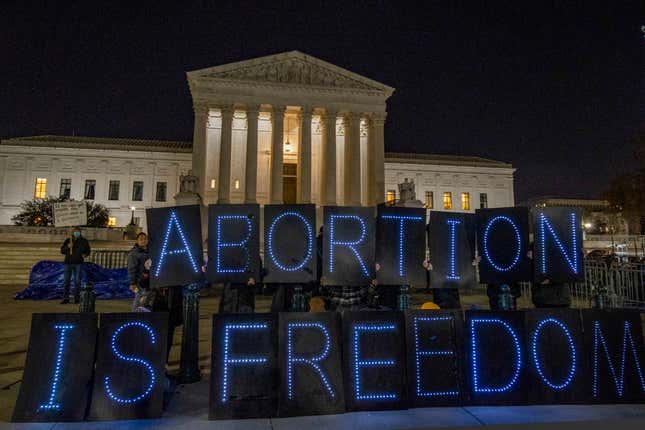Democrats Voted, and It Didn’t Save Abortion. What Now?
After now 49 years of Roe, in the face of federal inaction, advocates are increasingly focusing on state, local and community activism.
AbortionPolitics

Abortion is a constitutionally protected right. That was the promise the Supreme Court made to Americans in 1973. But after decades of targeted restrictions on abortion providers, the right seems just out of reach for millions. Crystal, a Pennsylvania-based abortion care worker, navigates every new hurdle with patients to get to their appointments, whether it’s legislative, economic or practical, but these days, it’s outside factors that get her down. “Anybody working in this field probably feels like we’re going to see the worst this year,” she told Jezebel. “The work gets harder and harder and harder. These last few months have been really difficult.”
Providing and receiving abortion care is only going to get more grim this year. Saturday is the 49th and possibly last anniversary of Roe v. Wade, and the anniversary comes after a chilling year for bodily autonomy. In December, the ultra-conservative Supreme Court heard arguments to directly challenge the constitutionality of abortion in Dobbs v. Jackson Women’s Health Organization, which capped off a year that saw 108 abortion restrictions passed in 19 states. After the passage of Texas’ S.B. 8 banning abortion after 6 weeks and instituting civil actions against anyone who aided or abetted an abortion in September, conservative state legislatures tripped over each other to pass their own Texas-style abortion bans, all while the COVID-19 pandemic continues to rage across our respiratory systems.
All while Democrats hold power in Congress and the White House.
Even as a party that explicitly endorsed abortion rights in its platform, Democratic lawmakers have few gains in reproductive rights to show their constituents, leaving many advocates disappointed by federal inaction from a president who can’t seem to bring himself to utter the word abortion.
“It’s my position that Republicans and Democrats are two sides of the same coin, and regardless of party, it’s our job as constituents to hold these people accountable or fire them,” Toni Watkins, voter mobilization director of URGE (Unite for Reproductive and Gender Equity), told Jezebel.
This year, with midterm elections on the horizon, Watkins is leading URGE’s electoral organizing efforts in a three-pronged approach to advance reproductive justice at the ballot box by “identifying the issues that move people to vote, identifying the barriers that they face in accessing their right to vote,” and then “registering the tens of thousands of people in our key states that are turning 18” before the election.
“Young, Black and brown voters are the most impacted by reproductive justice issues — it’s our families that are torn apart by the criminal justice system, our mothers who are most likely to die in childbirth, our elderly that are denied health care, our children that live in food deserts,” Watkins said. Yet, young people of color have historically been excluded from both voter mobilization efforts, and a national reproductive rights movement that’s historically centered cis, white women and ignored varying barriers and experiences that disproportionately impact the reproductive lives of people of color.
Watkins believes mobilization on the state and local levels, inclusive of communities of color, will be critical to advancing reproductive justice, as federal legislation like the Women’s Health Protection Act (WHPA), which would protect reproductive health providers’ right to provide care, and toothless pledges from Congressional Democrats and the White House to “codify Roe,” stagnate. That’s why URGE is particularly focused on state and local elections and ballot measures this year — and it’s not alone.
Sister District was founded in 2016 by an all-women leadership team to partner — or “sister” — volunteers from strongly Democratic state legislative districts with carefully targeted races in swing districts in other states, to help flip legislatures across the country, and enact a progressive legislative agenda. With midterms on the horizon, Lala Wu, executive director and co-founder of Sister District, sees state legislatures as “a critically overlooked venue of power” to protect and even expand reproductive rights across the country.
-

-

-

-

-

-

-

-

-

-

-

-

-

-

-

-

-

-

-

-

-

-

-

-

-

-

-

-

-

-

-

-

-

-

-

-

-

-

-

-








































